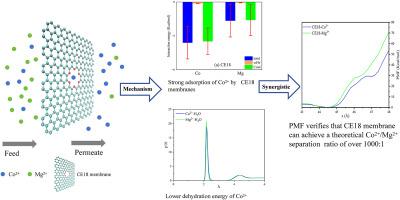电渗析过程中分离Co2+/Mg2+的冠醚石墨烯膜的分子洞察
IF 9
1区 工程技术
Q1 ENGINEERING, CHEMICAL
引用次数: 0
摘要
功能化冠醚修饰的石墨烯膜具有良好的离子分离性能。本研究通过分子动力学模拟,比较了嵌入冠醚纳米孔的石墨烯膜,即18冠-6-醚(CE18)和24冠-8-醚(CE24)对Co2+/Mg2+的分离效率。CE18膜的分离性能优于CE24膜,这是由于膜对二价离子的选择性吸附和脱水作用所致。与Mg2+相比,CE18膜对Co2+的吸附能力更强,分离率更高。相比之下,CE24膜对两种二价离子的吸附比CE18低一个数量级,导致分离效率较差。CE18膜较小的孔径迫使二价离子在跨膜过程中剥离更多的水合水分子,而Co2+失去每个水分子的脱水能低于Mg2+。脱水次数和自由能的共同作用提高了CE18膜的离子选择性,而CE24膜对Co2+和Mg2+的分离效果较差。CE基团与二价离子之间的吸附提高了CE18膜的离子通量和选择性,但不足以补偿脱水所需的能量。本研究在分子尺度上阐明了冠醚膜分离Co2+和Mg2+的结构-能-功能关系,为高性能离子交换膜的设计提供了一些启示。本文章由计算机程序翻译,如有差异,请以英文原文为准。

Molecular insight into crown ether graphene membranes for the separation of Co2+/Mg2+ in electrodialysis processes
Functionalized crown ether modified graphene membranes have exhibited promising capability for the separation of ions. In this study, graphene membranes embedded with crown ether nanopores, namely 18-crown-6-ether (CE18) and 24-crown-8-ether (CE24) were compared for their separation efficiency of Co2+/Mg2+ using molecular dynamics simulation. The separation performance of the CE18 membrane was superior to that of the CE24 membrane, which was attributed to the selective adsorption of membrane to the divalent ions, combined with the dehydration effect. The CE18 membrane had stronger adsorption to Co2+ compared to Mg2+, leading to greater separation ratio. In contrast, the adsorption of the CE24 membrane with both divalent ions was an order of magnitude lower than CE18, and resulted in poor separation efficiency. Smaller pore size of CE18 membranes forced the divalent ions to strip more hydrated water molecules during the transmembrane process, while the dehydration energy of Co2+ to lose each water molecule was lower than that of Mg2+. The combined effects of dehydration number and free energy improved the ion selectivity of the CE18 membrane, whereas the CE24 membrane was less preferable for the separation of Co2+ and Mg2+. The adsorption between the CE groups and the divalent ions advanced the ion flux and selectivity of the CE18 membrane, but it was insufficient to compensate the energy needed for dehydration. This study elucidated the structure-energy-function relationship of crown ether membranes for the separation of Co2+ and Mg2+ on the molecular scale, and shed some light for the design of high-performance ion exchange membranes.
求助全文
通过发布文献求助,成功后即可免费获取论文全文。
去求助
来源期刊

Journal of Membrane Science
工程技术-高分子科学
CiteScore
17.10
自引率
17.90%
发文量
1031
审稿时长
2.5 months
期刊介绍:
The Journal of Membrane Science is a publication that focuses on membrane systems and is aimed at academic and industrial chemists, chemical engineers, materials scientists, and membranologists. It publishes original research and reviews on various aspects of membrane transport, membrane formation/structure, fouling, module/process design, and processes/applications. The journal primarily focuses on the structure, function, and performance of non-biological membranes but also includes papers that relate to biological membranes. The Journal of Membrane Science publishes Full Text Papers, State-of-the-Art Reviews, Letters to the Editor, and Perspectives.
 求助内容:
求助内容: 应助结果提醒方式:
应助结果提醒方式:


